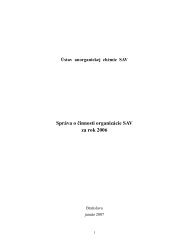Foreign Cooperating Institutions - Institute of Inorganic Chemistry ...
Foreign Cooperating Institutions - Institute of Inorganic Chemistry ...
Foreign Cooperating Institutions - Institute of Inorganic Chemistry ...
You also want an ePaper? Increase the reach of your titles
YUMPU automatically turns print PDFs into web optimized ePapers that Google loves.
HIGHLIGHTS OF THE IIC SCIENCE<br />
The scientific activity <strong>of</strong> the <strong>Institute</strong> <strong>of</strong> <strong>Inorganic</strong> <strong>Chemistry</strong> is concentrated to the<br />
fundamental, applied and industry oriented research <strong>of</strong> the inorganic systems suitable for<br />
design <strong>of</strong> new materials and/or technologies. Presented in the following pages are brief<br />
summaries <strong>of</strong> recent scientific highlights.<br />
New theoretical approaches for relativistic calculations <strong>of</strong> NMR<br />
parameters for compounds containing heavy elements<br />
M. Repiský, S. Komorovský, P. Hrobárik, O. L. Malkina, V. G. Malkin<br />
An accurate prediction <strong>of</strong> electronic structure and properties <strong>of</strong> compounds containing heavy<br />
elements obligatorily requires inclusion <strong>of</strong> relativistic effects into consideration. It means that<br />
instead <strong>of</strong> working with the Schrödinger equation one has to deal (in one way or other) with<br />
the Dirac equation extended for treatment <strong>of</strong> many-electron systems. Nowadays it becomes a<br />
common point that relativity has an especially immense effect on NMR shielding tensor and<br />
indirect nuclear spin-spin coupling constants (SSCC). Often calculations <strong>of</strong> those properties<br />
serve as a very delicate probe to test different ways <strong>of</strong> treating relativistic effects and the basis<br />
set quality. Lately we succeeded in the development <strong>of</strong> new relativistic four-component<br />
density functional approach based on the use <strong>of</strong> restricted magnetically balanced basis<br />
(mDKS-RMB) for calculations <strong>of</strong> NMR shielding [1]<br />
and indirect nuclear spin-spin coupling constants [2]. The<br />
unperturbed equations are solved with the use <strong>of</strong> a<br />
restricted kinetically balanced basis set for the small<br />
component, while to solve the second-order coupled<br />
perturbed DKS equations a restricted magnetically<br />
balanced basis set for the small component is applied.<br />
The method provides an attractive alternative to existing<br />
approximate two-component methods with transformed<br />
Hamiltonians for relativistic calculations <strong>of</strong> spin-spin<br />
coupling constants <strong>of</strong> heavy-atom systems. In particular,<br />
no picture-change effects arise in our method for<br />
property calculations. Pilot benchmark relativistic<br />
calculations show a high reliability <strong>of</strong> the mDKS-RMB<br />
methods. Recently, this method was extended to include<br />
GIAO (Gauge Including Atomic Orbitals) formalism.<br />
Our new method increases the accuracy in calculations<br />
<strong>of</strong> NMR and EPR parameters <strong>of</strong> compounds containing<br />
even as heavy elements as lanthanides or actinides.<br />
Further information: V. Malkin:<br />
vladimir.malkin@savba.sk<br />
1. Komorovský S., Repiský M., Malkina O. L., Malkin V. G., Malkin Ondik I., Kaupp M.: J. Chem.<br />
Phys. 128, 104101-1-104101-15, 2008<br />
2. Repiský M., Komorovský S., Malkina O. L., Malkin V. G.: Chem. Phys. 356, 236-242, 2009<br />
8



